Swiss Army Orifice
 Wednesday, February 8, 2012 at 04:16AM
Wednesday, February 8, 2012 at 04:16AM 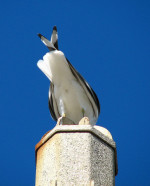 A gull's butt. Photo by EliyaPerhaps the grass is always greener on the other side of the evolutionary tree. How often do we wish we could fly, or breathe underwater, or run faster, or change our skin colour to match the décor? We seem to spend comparatively less time recognising the joys of opposable thumbs, self-awareness and bipedalism. Well if that’s the way it is, so be it. Here’s another impressive feature – in this case an organ – shared by many vertebrates, but not us. I give you the cloaca.
A gull's butt. Photo by EliyaPerhaps the grass is always greener on the other side of the evolutionary tree. How often do we wish we could fly, or breathe underwater, or run faster, or change our skin colour to match the décor? We seem to spend comparatively less time recognising the joys of opposable thumbs, self-awareness and bipedalism. Well if that’s the way it is, so be it. Here’s another impressive feature – in this case an organ – shared by many vertebrates, but not us. I give you the cloaca.
Actually I think the phrase “I give you the cloaca” has great potential, either as a compliment (keep reading) or an insult (keep reading).
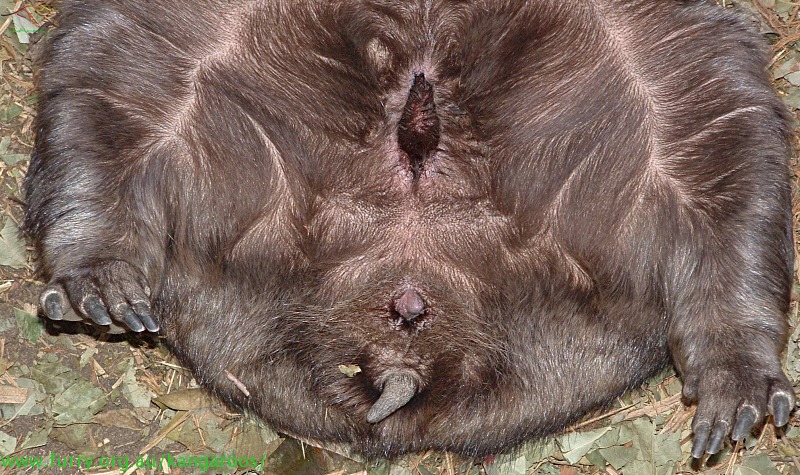 A wombats underside, showing pouch and cloaca. Photo by furry.org.auBirds have them, reptiles have them, amphibians, monotremes and even some marsupials have them. Dinosaurs might have had cloacae too and what an organ it is. It is an orifice shared by both the digestive and reproductive systems. It is used for the excretion of both faeces and urine, for mating and the release of eggs. So while we’re fumbling about with 2 or 3 different organs for these important functions, those among us blessed with a cloaca have, perhaps, a simpler and more elegant design. Of course it’s not quite that simple. In birds, reproduction results from a “cloacal kiss”, when the cloaca of the copulating creatures are everted and touch for long enough for sperm to be transferred from male to female. How sweet. Even among those few bird genera that appear to have a penis (eg ducks, geese and swans) this is basically an engorged cloaca. In contrast to a mammalian penis, it is engorged with lymph, rather than blood.
A wombats underside, showing pouch and cloaca. Photo by furry.org.auBirds have them, reptiles have them, amphibians, monotremes and even some marsupials have them. Dinosaurs might have had cloacae too and what an organ it is. It is an orifice shared by both the digestive and reproductive systems. It is used for the excretion of both faeces and urine, for mating and the release of eggs. So while we’re fumbling about with 2 or 3 different organs for these important functions, those among us blessed with a cloaca have, perhaps, a simpler and more elegant design. Of course it’s not quite that simple. In birds, reproduction results from a “cloacal kiss”, when the cloaca of the copulating creatures are everted and touch for long enough for sperm to be transferred from male to female. How sweet. Even among those few bird genera that appear to have a penis (eg ducks, geese and swans) this is basically an engorged cloaca. In contrast to a mammalian penis, it is engorged with lymph, rather than blood.
Most male reptiles have a penis and mating happens via the female cloaca. Male tuatara’s however, have managed to resist the temptation of the penis and are still using a cloaca.
Echidnas and platypuses, the world’s only monotremes, have cloacae. Indeed the very word “monotreme” refers to the cloaca. It comes from the Greek monos, meaning "single" and trema "hole". Furthermore, monotremes, reptiles and amphibians can have a several glands inside their cloacae which secrete a variety of substances useful in marking scents and reproduction.
The cloaca, it seems, is the Swiss Army knife of organs, but it has one more wonderful surprise and it happens in turtles. Turtles are reptiles, and many of them enjoy an aquatic environment. When in water, turtles need to re-surface periodically to breathe, so you might imagine that over time they might get rather good at holding their breath and indeed they have. Marine turtles can hold their breathe for hours, but some species have bypassed the need for breath holding, by evolving the ability the ability to breathe through their cloaca – cloacal respiration. Inside their cloacae they have a pair of bursae (singular, bursa), which are essentially large flexible sacs. These are lined with fimbriae – long thread-like protrusions rich with blood supplying capillaries. By flexing its internal muscles, the turtle is able to pump water in and out of the bursae and extract oxygen via the fimbriae.
 A Fitzroy River turtle demonstrating cloacal respiration. Photo by Craig Latta, www.turtles.net.auSome turtle species hibernate under water (often under ice) during which time they receive what little oxygen they need by cloacal respiration, but other species seem to prefer this form of breathing. Perhaps the most famous example is the Fitzroy River Turtle (Rheodytes leukops), which get’s more of its oxygen in this way than by normal breathing.
A Fitzroy River turtle demonstrating cloacal respiration. Photo by Craig Latta, www.turtles.net.auSome turtle species hibernate under water (often under ice) during which time they receive what little oxygen they need by cloacal respiration, but other species seem to prefer this form of breathing. Perhaps the most famous example is the Fitzroy River Turtle (Rheodytes leukops), which get’s more of its oxygen in this way than by normal breathing.
Now if you think I’m into cloacae, consider the sea cucumber. It has a cloaca that benefits not just itself, but others organisms. Tiny fish, worms and crabs often enter the sea cucumber’s cloaca and take up residence. As the sea cucumber is another creature that practices cloacal respiration, there’s plenty of oxygen for the tenants, invaluable shelter, and frequent opportunities to move in and out of their host (to search for food, etc) as the sea cucumber breathes.
It might be cloaca envy that leads so many humans to talk out of an unconventional orifice, but perhaps that is not as strange as it sounds. Even humans have a cloaca for a brief time. As embryos we do have a cloaca, but this is split up into separate reproductive, digestive and urinary tracts as we develop.
So we find ourselves cloacaless, but don’t be too disappointed, especially about the whole breathing through your cloaca – imagine your breath!
Time, it is a-changin'
 Saturday, November 5, 2011 at 08:14PM
Saturday, November 5, 2011 at 08:14PM  Image by AZRainmanEarly in 2012, the International Telecommunication Union (ITU) will meet in Geneva to talk about time. Specifically they will be considering a proposal to change the way we keep time, away from Greenwich Mean Time (GMT) and towards the more precise time kept by hundreds of atomic clocks around the world. Why are they considering this? Simply because determining “clock” time by the passing of the sun over any point of the Earth’s surface is inaccurate.
Image by AZRainmanEarly in 2012, the International Telecommunication Union (ITU) will meet in Geneva to talk about time. Specifically they will be considering a proposal to change the way we keep time, away from Greenwich Mean Time (GMT) and towards the more precise time kept by hundreds of atomic clocks around the world. Why are they considering this? Simply because determining “clock” time by the passing of the sun over any point of the Earth’s surface is inaccurate.
Evolution has tuned us into the rising and setting of the sun and it's tempting to assume that the Earth (and its daily rotation) is constant. It’s not.
We have known for hundreds of years that the actual length of days fluctuates.
As it happens, the term “GMT” has really only hung on for reasons of tradition. GMT was replaced in 1925 by “Universal Time” (UT) and again in 1972 by “Universal Coordinated Time” (UCT). In order to synchronise with “real” time (as measured by atomic clocks) leap seconds are occasionally added to UCT.
The current proposal is to redefine UTC entirely in line with the time kept by atomic clocks and abolish leap seconds, so that the passing of time is not tied to the rotation of the Earth. This would mean that over time, UTC would gradually move further and further out of step with the rising and setting of the sun.
Philosophically this might alter the way we think about time passing, but it will take hundreds of years and is not as catastrophic as some have suggested. According to AFP (reported on news.com.au), Britain’s science minister David Willetts has opposed the plan, suggesting that "Without leap seconds we will lose contact with the reality of Earth's rotation. Eventually our midnight would happen at noon."
I think Willets has missed the point. Midnight will always be where is has been – in the middle of the night - but 12am might mean different things in different places. What has 12am ever really meant anyway? Ask people who live at high latitudes. For significant parts of the year 12am is still light and at other times 12pm is dark. Our connection to the daily rotation of the Earth is as secure as it ever was. It’s just that sundials will indicate a different time to atomic clocks. I’m sure we’re smart enough can accommodate both if we need to.
If you’re interested, ITU is the United Nations agency for information and communication technologies. These are the people who (among other things) allocate global radio spectrum frequencies and satellite orbits, and develop ICT technical standards. This is important work, because without global standards for telephone and internet systems (for example) the connectivity and cooperation that we take for granted would be impossible. For a sense of what ITU does, the video on this page is actually pretty good.
 GMT,
GMT,  ITU,
ITU,  International Telecommunication Union,
International Telecommunication Union,  UCT,
UCT,  atomic clock,
atomic clock,  time
time Tesla and the Teenage Brain
 Saturday, July 9, 2011 at 04:26AM
Saturday, July 9, 2011 at 04:26AM  Nikola Tesla was probably a genius. Even as a youngster he was clever and inventive. He may well have been rather different to modern teenagers, but that does not mean that there is not connection. Tesla was awarded more than 100 patents and is credited with the invention of the first automobile speedometer, fluorescent lighting, alternating current (AC), the radio, the first remote controlled toy (a boat) and wireless electricity (I can’t wait for that to become a household reality – real wireless living). He also invented the rotating magnetic field. This is a magnetic field which changes direction at a constant angular rate.
Nikola Tesla was probably a genius. Even as a youngster he was clever and inventive. He may well have been rather different to modern teenagers, but that does not mean that there is not connection. Tesla was awarded more than 100 patents and is credited with the invention of the first automobile speedometer, fluorescent lighting, alternating current (AC), the radio, the first remote controlled toy (a boat) and wireless electricity (I can’t wait for that to become a household reality – real wireless living). He also invented the rotating magnetic field. This is a magnetic field which changes direction at a constant angular rate.
A rotating magnetic field makes it possible to maintain a homogeneous magnet field. It is based on such a field that MRI (magnetic resonance imaging) machines operate, but it needs to be a really, really strong magnetic field.
This sort of magnetic field is produced and maintained by a superconducting magnet, made up of lots and lots of coiled wire, through which an electric current is passed.
What's all this got to with teenagers? Fair question, keep reading.
Now, there is a lot of water in the human body, which means there is a lot of hydrogen in the (H2O). These hydrogen atoms each have a nucleus with one proton. In the body (and almost everywhere else) these protons are randomly spinning, or precessing, on their axes in all different directions. When placed in a magnetic field, the protons line up in the direction of the field.
The MRI machine then produces a radio frequency (RF) pulse that oscillates at the same frequency as the precessing hydrogen protons. The RF pulse forces the protons to spin at a particular frequency, in a particular direction.
When the RF pulse is turned off, the hydrogen protons return to their previous alignment and release the energy absorbed from the RF pulses. This energy is detected by the MRI, which is analysed by a computer to produce an image.
Researchers in Prof. Sarah-Jayne Blakemore’s lab at University College London used MRI to compare teenager’s brains to adult brains. The Blakemore Lab researchers looked at how well teenagers and adults could do a simple task, while being actively distracted.
The task involved classifying letters of the alphabet according to whether they were made of straight lines or curved lines. Sometimes the teenagers and adults were shown the letters, and other times they had to imagine the letters.
They found that when the adults and teenagers had to imagine the letters, the adults completed the task faster than the teenagers. They also discovered that as people got older they took longer to complete the tasks but they were more accurate.
While this was going on, the researches also used MRI scans to create images of the brains involved.
They found some minor differences in the structures of teenage and adult brains, and also noticed that teenagers and adults used slightly different areas of their brains when they were completing the tasks.
When they combined all the data they collected, they found that as our brains develop they learn new ways to avoid distractions and imagine objects. This process happens during our teenage years.
So it seems that through the mind of Tesla, we have been able to peer inside the head of everyone else, to watch their brains develop. This goes some way to explaining teenage behaviour too, and if you want to escape a teenager, try showing them something shiny and slipping away while they’re not looking.
This research inspired Great Big Science Gig to write this song.
Seeds of No Doubt
 Sunday, February 6, 2011 at 03:43AM
Sunday, February 6, 2011 at 03:43AM  The entrance to the Svalbard Global Seed Vault, rising from the permafrost like a Bond villain’s lair. Photo by Mari Tefre/Global Crop Diversity Trust.Seeds are a bit fabulous. They are a valuable source of food products (rice, wheat, corn, flours, oils, alcohol, etc), they are a wonderfully efficient component of plant reproduction and they are a critical supply of the world’s collective plant genome.
The entrance to the Svalbard Global Seed Vault, rising from the permafrost like a Bond villain’s lair. Photo by Mari Tefre/Global Crop Diversity Trust.Seeds are a bit fabulous. They are a valuable source of food products (rice, wheat, corn, flours, oils, alcohol, etc), they are a wonderfully efficient component of plant reproduction and they are a critical supply of the world’s collective plant genome.
Another thing that warrants a degree of excitement is the Svalbard Global Seed Vault (SGSV). If you’re unfamiliar with the seed vault, it was opened in 2008 at Svalbard, the northernmost place on earth that has regular flights (about one a day I believe). The seed vault is positioned about 120 metres inside a mountain on Spitsbergen Island, a location chosen because of its environmental and political stability.
In 2009, The Economist ranked Norway as the most politically stable country in a list of 165 and the area characterised by a lack of tectonic activity. In addition, the permafrost provides temperature stability and at 130 metres above sea level, it is well out of reach of sea level rise, predicted as a result of global warming.
The seeds are contained in four-ply packets, which are heat sealed to exclude moisture. They are housed in refrigerated rooms, kept at a constant -18oC. Power to the vault comes from a coal power station. Should this power supply fail, it is believed the permafrost would greatly slow any resulting warming possibly for weeks. Even then it would only warm to about -3oC (the ambient temperature of the mountain bedrock).
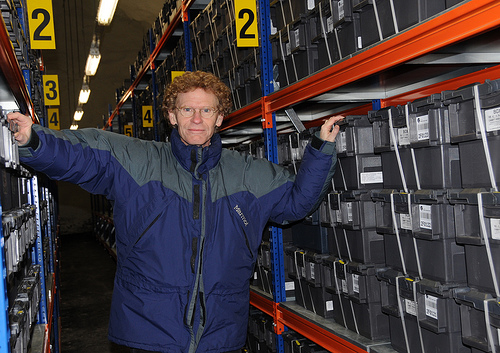 Cary Fowler, Executive Director of the Global Crop Diversity Trust, surrounded by shelves stocked with stacks of seeds. Photo by Mari Tefre/Global Crop Diversity Trust.Under these conditions it is believed that many seed types could remain viable for hundreds of years, some perhaps for thousands.
Cary Fowler, Executive Director of the Global Crop Diversity Trust, surrounded by shelves stocked with stacks of seeds. Photo by Mari Tefre/Global Crop Diversity Trust.Under these conditions it is believed that many seed types could remain viable for hundreds of years, some perhaps for thousands.
Should current crop species fall victim to disease or if climate change alters conditions in a particular location such that a particular species is no longer able to grow there, it is to seed banks such as the SGSV that we will need to turn for alternatives. This is just one of the many reasons to maintain biodiversity, as there are tens of thousands of edible, but presently uncultivated crop species.
Several of Australia’s seed banks are no longer being maintained and there were never very many in the first place. This disappointing situation is explored in the article from Cosmos from September last year. It is perhaps bittersweet then, that later this month Australia will make it’s first deposit in the SGSV. Dr Tony Gregson and Prof. Edwina Cornish will deliver samples from Horsham in Victoria.
 Seeds in bags, prepared for transport to Svalbard. Photo by WARDA.It should also be that the SGSV is a very cool looking facility as the photos on this page show. There are more photos at the Global Crop Diversity Trust Flickr page. There is also loads of information about global efforts to secure seed and plant diversity at the Global Crop Diversity Trust site.
Seeds in bags, prepared for transport to Svalbard. Photo by WARDA.It should also be that the SGSV is a very cool looking facility as the photos on this page show. There are more photos at the Global Crop Diversity Trust Flickr page. There is also loads of information about global efforts to secure seed and plant diversity at the Global Crop Diversity Trust site.
It’s been many years since I was in Scandinavia and this one place that I’d love to visit, not just because it’s such a great looking place, but also for the adventure and because of its invaluable role in maintaining global biodiversity.
Do Good, Feel Good, Is Good
 Sunday, December 19, 2010 at 07:41AM
Sunday, December 19, 2010 at 07:41AM  Image by 'smil.As we enter the festive season (Christmas, Hanukkah, winter solstice, etc) my mind turned to the act of gift giving and I was reminded of a piece I presented on Einstein a Go Go about altruism. Altruism can be defined as a selfless concern for the wellbeing of others. This implies that to show altruism, one needs to aware of self (and presumably that which is non-self). Only a few organisms show evidence of self-awareness, and we know that humans are one of these animals.
Image by 'smil.As we enter the festive season (Christmas, Hanukkah, winter solstice, etc) my mind turned to the act of gift giving and I was reminded of a piece I presented on Einstein a Go Go about altruism. Altruism can be defined as a selfless concern for the wellbeing of others. This implies that to show altruism, one needs to aware of self (and presumably that which is non-self). Only a few organisms show evidence of self-awareness, and we know that humans are one of these animals.
The meaning of life is to live long enough to pass on your genes as many times as possible. Staying alive, however is not easy, so this does not simply mean being selfish.
We share many of our genes with our families and evolution has lead to very strong familial bonding. When threatened, we are usually very defensive of our kinfolk. Over millennia - for most of human history in fact - we have lived in extended family groups and tribes. These groups have developed rules of behaviour, which are of benefit to the whole group. This might include gathering food to share, helping raise children, building shelters and working together to protecting the group from predators or rivals. These rules have developed into social norms that are still common in most societies.
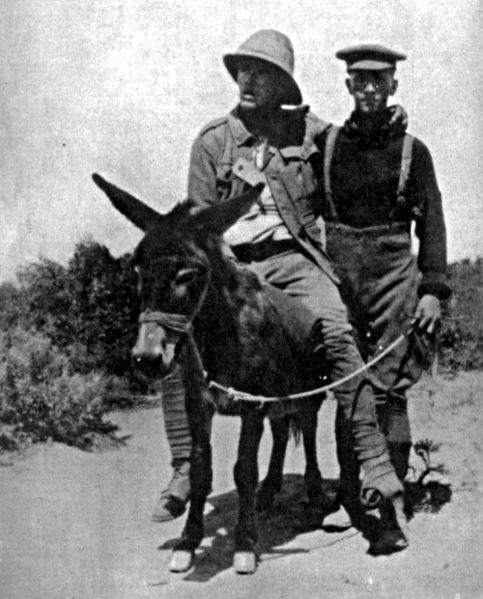 But is it really selfless to help others because that is what’s best for everyone – including you? This is more accurately reciprocal altruism.
But is it really selfless to help others because that is what’s best for everyone – including you? This is more accurately reciprocal altruism.
In 2006 Jorge Moll and Jordan Grafman, used fMRI to examine what happens in the brain during acts of altruism. When subjects received a monetary reward, the mesolimbic pathway lit up. This part of the brain also lights up in response to food and sex. Interestingly this section also lit up when subjects made a charitable donation. The really interesting bit is that the when making a charitable donation, the subject’s sub-genual cortex/septal region also lit up. These structures are very closely related to social attachment and bonding in other species. Altruism it seems might be a very basic and pleasure-rewarding part of our makeup.
If we define altruism as acts that are of clear benefit to other individuals and to groups, rather than simply acts that benefit the individual, then organisms that exhibit these behaviours are far more common.
Bonobos have been observed aiding injured or handicapped bonobos and vampire bats will regurgitate blood to share with sick roost mates or bats that have been unable to find a meal. Then there’s the intriguing case of dictyostelids. These are a group of cellular slime molds or social amoebae. When food is plentiful, they exist as individual amoebae, which feed and divide normally. However when the food is in short supply, they aggregate to form a multicellular assembly, called a pseudoplasmodium or slug. It seems that when the going gets tough, amoebae really stick together. The newly formed slug responds to changes in light and temperature, it is able migrate and it has a definite anterior and posterior. The slug is even able to reproduce, forming a fruiting body with a stalk that supports balls of spores. These spores remain inactive until food is once more available and they become new amoebae.
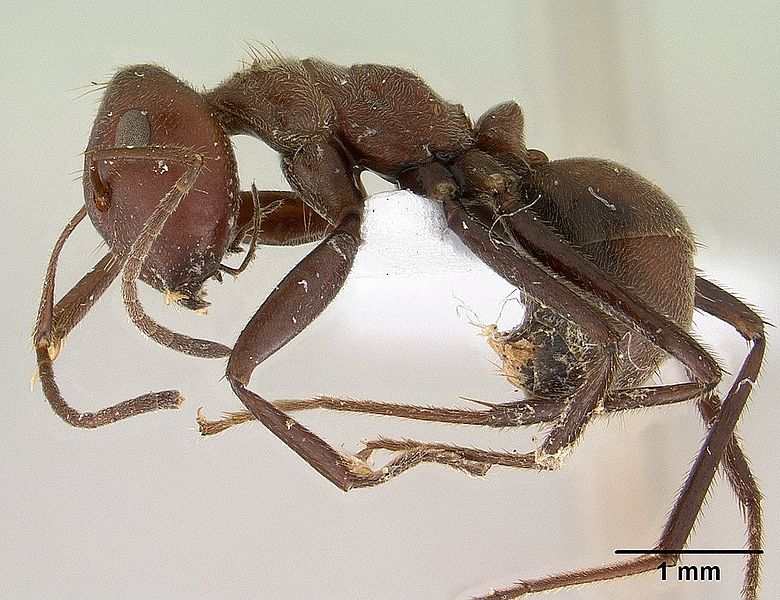 Camponotus saundersi. Image by Noel Tawatao (AntWeb).One of the most impressive examples of altruism belongs to a particular species of carpenter ant (of the Camponotus genus). Workers of these species are characterised by greatly enlarged mandibular glands that run the whole length of their body. If their nest is under threat by small insect attackers, they will violently contract their abdominal muscles, rupturing these glands and releasing a sticky poison. This poison (which contains acetophenones, among other thing) immobilises the victim and the act of releasing it in this way kills the ant. Suicidal altruism – that’s really taking one for the team. This was the inspiration for the Ologism track ‘Ant Establishmentism’.
Camponotus saundersi. Image by Noel Tawatao (AntWeb).One of the most impressive examples of altruism belongs to a particular species of carpenter ant (of the Camponotus genus). Workers of these species are characterised by greatly enlarged mandibular glands that run the whole length of their body. If their nest is under threat by small insect attackers, they will violently contract their abdominal muscles, rupturing these glands and releasing a sticky poison. This poison (which contains acetophenones, among other thing) immobilises the victim and the act of releasing it in this way kills the ant. Suicidal altruism – that’s really taking one for the team. This was the inspiration for the Ologism track ‘Ant Establishmentism’.
Recently, researchers at the Howard Hughes Medical Institute in Chevy Chase and Boston University showed that even humble E. coli bacteria are looking out for each other. To explore processes that underpin the development of antibiotic resistance, the researchers were growing bacteria in a bioreactor. They then trickled a synthetic antibiotic (norfloxacin) in to the bioreactor. As they raised the levels of antibiotic, the scientists periodically re moved samples of bacteria to determine the minimum amount of antibiotic needed to stop growth of the E. coli. They found that, taken as a whole, the bacteria population was more resistant than individual samples. To cut a longer story short, E. coli that were resistant to the antibiotic were producing indole, a substance that pumps the antibiotic out of the cell and protects the bacteria from the build up of toxic free radicals. The production of indole – while beneficial overall – comes at a cost. The resistant bacteria don't grow as well as they otherwise could, because they're producing indole for the other (non-resistant) bacteria.
Ever since Darwinian evolution began to gain traction, there have been those who have tried to simplistically characterise nature as cruel and founded in selfishness. Survival of the fittest, dog-eat-dog, it’s a jungle out there, etc. Rather, it seems that looking after each other is hardwired into us. It’s apparently of benefit to us all, so today do something nice for someone, and yourself.
